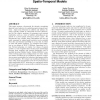Free Online Productivity Tools
i2Speak
i2Symbol
i2OCR
iTex2Img
iWeb2Print
iWeb2Shot
i2Type
iPdf2Split
iPdf2Merge
i2Bopomofo
i2Arabic
i2Style
i2Image
i2PDF
iLatex2Rtf
Sci2ools
ATAL
2006
Springer
2006
Springer
Robust recognition of physical team behaviors using spatio-temporal models
This paper presents a framework for robustly recognizing physical team behaviors by exploiting spatio-temporal patterns. Agent team behaviors in athletic and military domains typically exhibit an observable structure characterized by the relative positions of teammates and external landmarks, such as a team of soldiers ambushing an opponent or a soccer player moving to receive a pass. We demonstrate how complex team relationships that are not easily expressed by region-based heuristics can be modeled from data and domain knowledge in a way that is robust to noise and spatial variation. To represent team behaviors in our domain of MOUT (Military Operations in Urban Terrain) planning, we employ two classes of spatial models: 1) team templates that encode static relationships between team members and external landmarks; and 2) spatially-invariant Hidden Markov Models (HMMs) to represent evolving agent team configurations over time. These two classes of models can be combined to improve r...
| Added | 20 Aug 2010 |
| Updated | 20 Aug 2010 |
| Type | Conference |
| Year | 2006 |
| Where | ATAL |
| Authors | Gita Sukthankar, Katia P. Sycara |
Comments (0)

